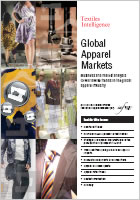Issue
4:
4th Quarter 2008

Product Overview
Buy this Issue now
Subscribe
Download brochure (PDF)
Download price list (PDF)
Price list download
| Please choose your preferred currency:
|
Request sample issue
View list of reports
in other issues
|
Multi Report Package |
We also offer a flexible subscription product,
the Multi Report Package,
which allows you to select your own choice of reports from our full range,
to suit your own budget.
Click here for full details.
|
|
 |
Prospects for the textile and garment industry in Hong Kong |
|
published in Issue 4, 4th Quarter 2008
|
Hong Kong is the world?s third largest exporter of garments, behind China and the EU, and a major exporter of textiles?reflecting its favoured position as one of Asia?s most prominent trading hubs. Textile and clothing exports stood at US$40 bn in 2008, representing 11% of total exports from the territory. Most of this trade, however, comprised re-exports of goods originating in mainland China and other low cost Asian countries.
Hong Kong?s domestic textile and garment sectors have been declining due to high manufacturing costs in the territory. In particular, labour and land costs are significantly higher than in most other Asian countries. Not surprisingly, there has been a strong trend, evident since the late 1980s, for manufacturers to subcontract operations to lower cost countries, especially mainland China.
Even so, Hong Kong still retains an important garment manufacturing industry which is the territory?s largest manufacturing activity. There is an emphasis on producing goods for the luxury market where innovation and fashion are essential attributes in attracting sophisticated international consumers. Important links have been established with some of the world?s most famous and exclusive brands.
Moreover, the textile and garment industries remain at the centre of the territory?s economy. The industries employ around 147,000 people, of whom 117,000 are involved in the export/import trade.
Looking ahead, Hong Kong will face growing competitive pressures as the textile and garment industries in other Asian countries expand and build up their design and manufacturing capabilities?and these pressures will need to be accommodated. On the other hand, business opportunities are being boosted by the ever closer business and economic links which are being developed between Hong Kong and mainland China.
- Prospects for the textile and garment industry in Hong Kong
-
- Summary
- Development of the textile and garment industry in Hong Kong
- Importance of the textile and garment industry to the economy of Hong Kong
- Hong Kong: geographical, political and economic profile
- Hong Kong: infrastructure
- Hong Kong: human resources
- Size and structure of the textile and garment industry in Hong Kong
- Textile and garment production in Hong Kong
- Production technology and machinery in Hong Kong?s textile and garment industry
- Markets for Hong Kong?s textile and garment industry: exports and brands
- Hong Kong?s textile and garment imports
- Textiles and garments in Hong Kong: government policies and foreign investment
- Textiles and garments in Hong Kong: strengths, weaknesses, opportunities and threats
| Global Apparel Markets provides intelligence, analysis and insight on the global apparel industry. |  | What's in it?
Each issue contains: essential information on trade and trade policy; news from leading brands, companies and other organisations; analysis of key geographical markets; and expert opinions on strategy. A single issue of Global Apparel Markets includes:  practical and strategic advice from industry experts practical and strategic advice from industry experts  a report on a key geographical market a report on a key geographical market  a round-up of the latest product innovations a round-up of the latest product innovations  a feature on trade and trade policy a feature on trade and trade policy  comprehensive information on the latest business developments comprehensive information on the latest business developments
An annual subscription to Global Apparel Markets is a cost-effective way to keep informed about trends and developments in the global apparel industry. Subscriptions are available in printed and/or digital formats. Printed and digital subscribers receive each issue in printed format in addition to a digital PDF file, which is available immediately on publication. Subscribers also receive a complementary digital subscription to Global Apparel Update, delivered directly by email once a month. This free supplement contains essential information on business news and the latest product developments. Like all Textiles Intelligence publications, Global Apparel Markets is a reliable source of independently sourced business information, and it does not carry advertising.
| This is what our customers say: |
"In our work, we were looking for industry insights and trends - who the major suppliers were, which countries were producing and what, productivity rates, investment incentives, where investors were moving to and why, etc. A lot of the individual country case studies you did were great - I remember one recently on the UK for example. There was also a great article from a guy on the Turkish market and recent trends there. Both these articles were written for the layman so they were easy to understand but comprehensive at the same time.
The technology articles were also interesting.
Basically, it was an all-round good publication that covered everything in enough depth so that you would always find something of interest in each issue." |
| (Alan J. Saffery; Competitiveness, Private Sector & Economic Growth ; Saffery Consulting) |
|
|
 |
